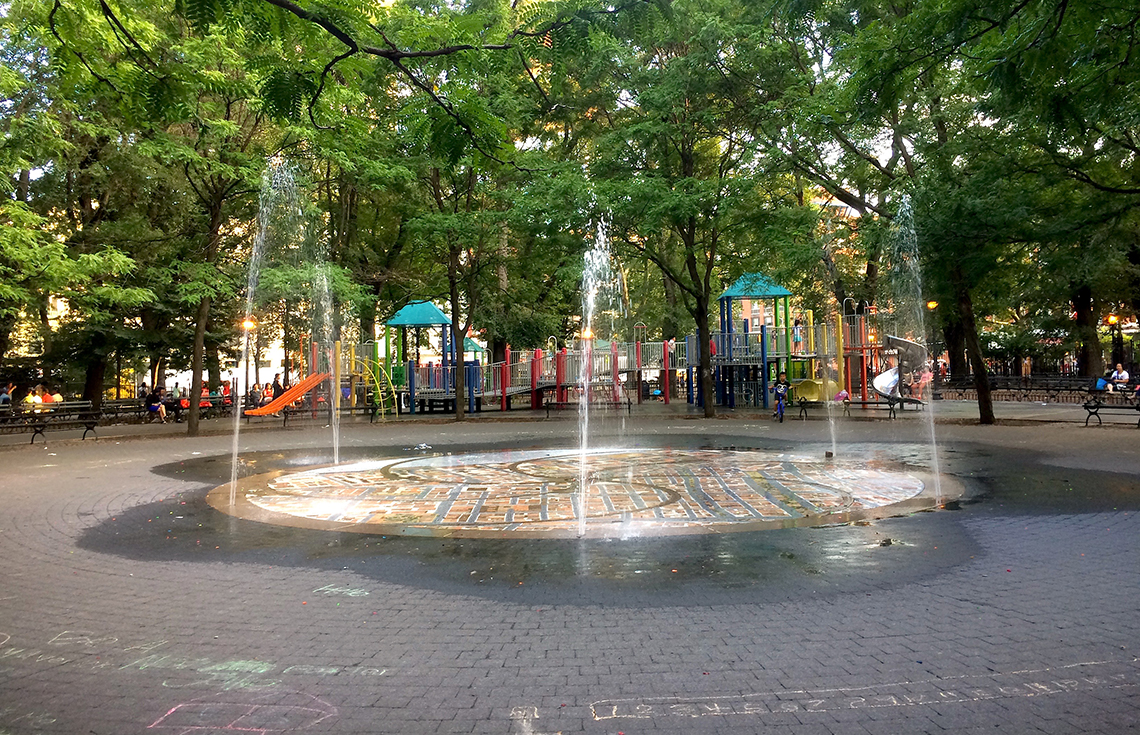Park Use and Childhood Physical Activity
Systematic Observations to Inform Enhanced Health Benefits of Neighborhood Parks for Low-Income and Minority Communities

Summary
To understand opportunities for childhood physical activity, the research team collected data in neighborhood parks across New York City, including "anchor parks" slated for enhancement in the coming years: St, Mary's Park in the South Bronx and Highbridge Park in upper Manhattan. A team led by Gina Lovasi, PhD, MPH and supervised by Dustin Fry worked closely with lead investigators from North Carolina State University (NCSU) to extend their park data collection to the high-density and diverse urban context of New York City. The NCSU research team conducted observations in parks in Raleigh-Durham, North Carolina in spring and summer of 2018, using parallel methods to facilitate comparisons.
The overall goal was to understand how to maximize opportunities for physical activity within neighborhood parks, leveraging knowledge about the use of patterns, preferences, and barriers that matter to low-income and minority communities. These efforts within the park complement surveys of neighborhood residents and the broader constellation of efforts supported by the Robert Wood Johnson Foundation-funded Physical Activity Research Center.
Partners
North Carolina State University, Department of Parks, Recreation and Tourism Management
Research Methods
The project mapped neighborhood and park features and described patterns of physical activity by different age, gender, and racial groups within the parks. Some of the tools used include:
- SOPARC -- System for Observing Play and Recreation in Communities to structure our observation of park use across multiple parks, times of day, and seasons.
- CPAT -- Community Park Audit Tool to be used in mapping park features.
- ANC -- Active Neighborhood Checklist was used to audit streets surrounding the parks.
Spring and summer observations by the research team in 20 parks across New York City included more than 1,000 rounds of SOPARC observations. Data collection is complete. The team continues to collaborate and publish papers.
Research Results
The following is a list of publications:
Marquet, O., Hipp, J. A., Alberico, C., Huang, J. H., Mazak, E., Fry, D., Lovasi, G. S., & Floyd, M. F. (2019). How does Park use and physical activity differ between childhood and adolescence? A focus on gender and race-ethnicity. Journal of Urban Health, 96(5), 692-702.
Marquet, O., Hipp, J. A., Alberico, C., Huang, J. H., Fry, D., Mazak, E., Lovasi, G. S. & Floyd, M. F. (2019). Use of SOPARC to assess physical activity in parks: do race/ethnicity, contextual conditions, and settings of the target area, affect reliability?. BMC Public Health, 19(1), 1730.
Marquet, O., Hipp, J. A., Alberico, C., Huang, J. H., Fry, D., Mazak, E., Lovasi, G.S., & Floyd, M. F. (2019). Park use preferences and physical activity among ethnic minority children in low-income neighborhoods in New York City. Urban Forestry & Urban Greening, 38, 346-353.
Marquet, O., Hipp, J. A., Alberico, C., Huang, J. H., Fry, D., Mazak, E., Lovasi, G. S., & Floyd, M. F. (2019). Short-term associations between objective crime, park-use, and park-based physical activity in low-income neighborhoods.
Preventive Medicine, 126, 105735.
Huang, J. H., Hipp, J. A., Marquet, O., Alberico, C., Fry, D., Mazak, E., Lovasi, G. S., Robinson, W.R., & Floyd, M. F. (2019). Neighborhood characteristics associated with park use and park-based physical activity among children in low-income diverse neighborhoods in New York City. Preventive Medicine, 105948.
Fry, D., Hipp, J. A., Alberico, C., Huang, J. H., Lovasi, G. S., & Floyd, M. F. Land use diversity and park use in New York City. Submitted for publication.
Acknowledgements
This work has been led by Principal Investigator Myron Floyd, PhD, MS, who has been a leader in the understanding of how parks can advance health equity, alongside other health-related goals. A special thanks to Co-Principal Investigator Aaron Hipp,PhD, and the rest of the investigative team. Special thanks also to Pedro Gullón Tosio, MD, PhD, Marie Skłodowska-Curie Research Fellow
Public Health and Epidemiology Research Group, University of Alcala in Madrid, Spain and the data collection team: Melika Behrooz, Anyelina Cantos, Emil Fraija, Tammy Kouffman, and Samiha Sherif.
Research Team
Funding is from the Robert Wood Johnson Foundation Physical Activity and Research Center (PI: Myron Floyd, PhD, MS; Subcontract PI: Gina Lovasi, PhD, MPH.